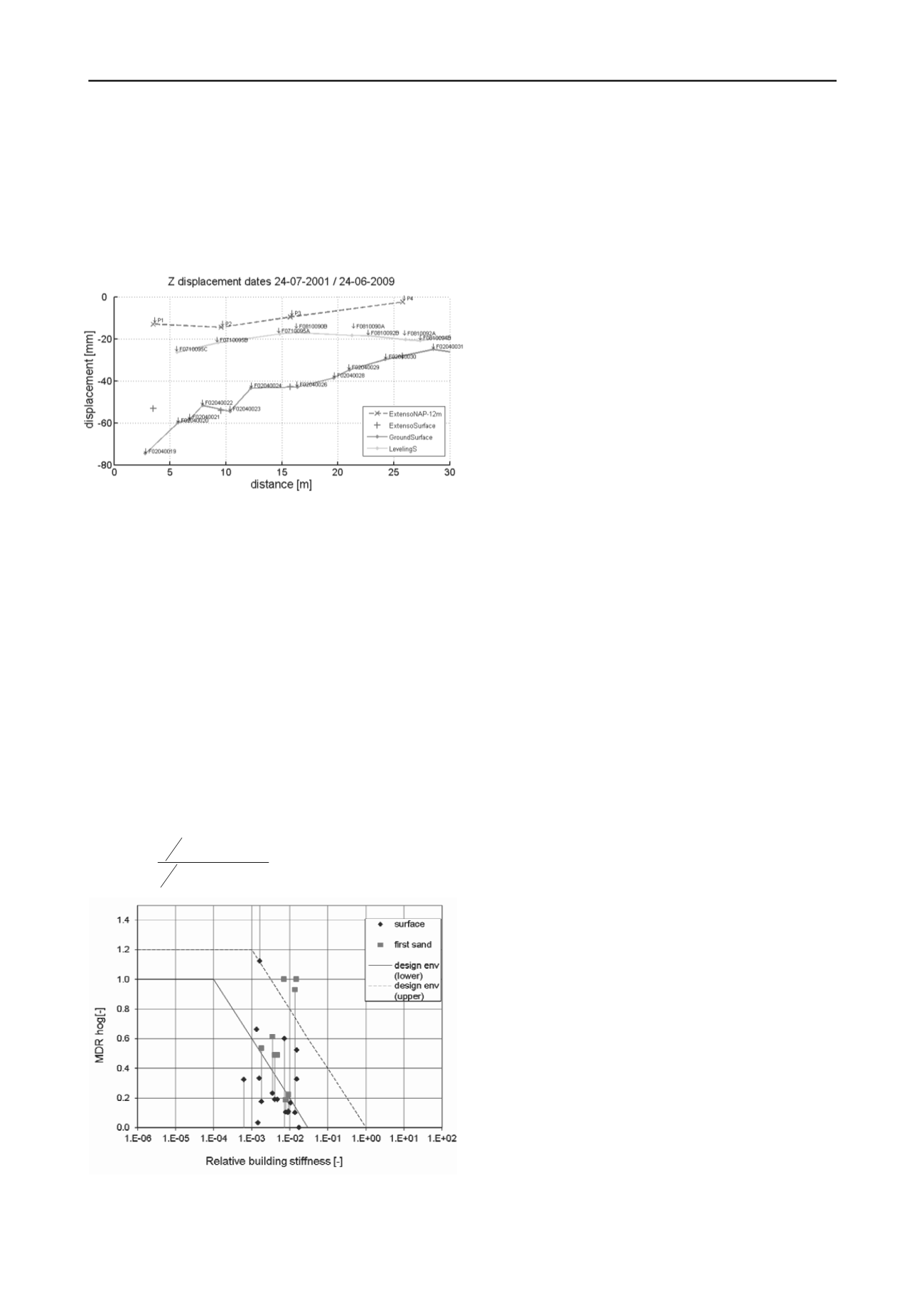
2038
Proceedings of the 18
th
International Conference on Soil Mechanics and Geotechnical Engineering, Paris 2013
In most cases in practice, no detailed information is present
about the foundation and the soil-pile interaction has to be
estimated or measured during construction.
For a second series of buildings with more modern
foundations (old timber piles combined with renovation steel
piles), the depth at which the pile and soil settlement are equal
is found at approximately 0.8 – 1.0 times the pile length, see
Figure 8.
The deflection of the buildings is clearly less than the
deflected shape of the surface (70% reduction). A reduction of
the deflection of 45% is found compared to the foundation
level. The variation in these factors can to a certain degree be
explained by the relative stiffness of the buildings compared to
the soil as shown in Figure 9.
Figure 8 Ground and building displacements for CS13110 (at
Ceintuurbaan) in the period 2001-2009
Based on the soil and building displacements as presented in
more detail in (Korff 2012), the average interaction between
pile and soil is found at 0.3 – 0.8 times the pile length for most
original timber pile foundations and 0.8-1.0 times the pile
length for most renewed foundations in the first sand layer.
Some modern buildings settle very little and the pile settles the
same as the pile tip level (1.0).
The settlement of the piles is shown to be between the
settlement of the surface and the foundation layer. The
deflection of the building is smaller than the deflection of either
of the surface or base level soil deflections due to the stiffness
of the building. The (Goh and Mair 2011) method to compare
building settlement with greenfield settlement was used to
determine the modification factors. In this case this was done
comparing with greenfield surface settlement and with
greenfield settlement of the foundation layer (first sand). For the
deflection of buildings next to excavations, deforming in
hogging shape, the modification factor is based on (Potts and
Addenbrooke 1996):
(4)
Figure 9 Modification factors from Amsterdam deep excavation for
surface level and foundation level, compared with the design envelope
presented by (Mair 2011)
6 CONCLUSIONS
Piled buildings adjacent to deep excavations have to be assessed
differently from buildings with shallow foundations. Piled
buildings settle an amount between the surface settlement (for
friction piles in failure) and tip level settlement (for end bearing
piles with sufficient capacity to take full negative skin friction).
The precise soil-pile interaction can be estimated based on the
pile load, the pile capacity and the shaft friction development
based on a method described in (Korff 2012). Based on
measurements of Amsterdam timber pile foundations, the pile
settlement is equal to the soil settlement at a depth of 0.3 – 0.8
times the pile length for most original timber pile foundations
and 0.8-1.0 times the pile length for most renewed foundations
in the first sand layer. Most of the modern buildings settle not
more than the pile tip level.
The method proposed by (Goh and Mair 2011) provides a
realistic, although rather large, range of possible modification
factors to estimate the building deflection compared to the
deflected shape of the soil surface and foundation level.
ACKNOWLEDGEMENTS
This research was performed in cooperation with the Dutch
Centre for Underground Construction (COB). The authors wish
to thank the city of Amsterdam for permission to use the data.
REFERENCES
Franzius J. N. Potts D. M. and Burland J. B. 2006. The response of
surface structures to tunnel construction.
Proc. Institution of the
Civil Engineers Geotechnical Engineering
1591, 3–17
Farrell R.P. 2010.
Tunnelling in sands and the response of buildings.
Ph.D thesis Cambridge University UK.
Goh K.H. and Mair R.J. 2011. The response of buildings to movements
induced by deep excavations.
Geotechnical Aspects of
Underground Construction in Soft Ground - Proceedings of the 7th
International Symposium on Geotechnical Aspects of Underground
Construction in Soft Ground
Rome, 903-910.
Hoekstra J. and Bokhoven W. 1974.
Systematisch funderingsonderzoek
van de Dapperbuurt “Systematic foundation research in the
Dapperbuurt area”.
Laboratorium voor Grondmechnica Delft
reference CO-21606/503 In Dutch.
Hsieh P. G. and Ou C. Y. 1998.. Shape of ground surface settlement
profiles caused by excavation.
Canadian Geotechnical Journal
35,
1004–1017.
Jacobsz S. W.; Bowers K.H.; Moss N.A.; Zanardo G. 2005. The effects
of tunnelling on piled structures on the CTRL.
Geotechnical
Aspects of Underground Construction in Soft Ground
Amsterdam
Taylor&Francis Group London.
Korff M. 2012.
Response of piled buildings to the construction of deep
excavations.
Ph.D thesis Cambridge University
Mair R.J. 2011. Tunnelling and deep excavations - Ground movements
and their effects. Keynote Lecture.
Proceedings of the XV
European Conference in Soil Mechanics and Geotechnical
Engineering ECSMGE-Athens..
Potts D. M. and Addenbrooke T. I. 1996. The influence of an existing
structure on the ground movements due to tunnelling.
Geotechnical
Aspects of Underground Construction in Soft Ground
London.
van Tol A.F. 1994.
Hoe betrouwbaar is de paalfundering?
Lecture at
installation as professor at Delft University of Technology
Xu K.J. and Poulos H.G. 2000. Theoretical Study of Pile Behaviour
Induced by a Soil Cut.
Proceedings GeoEng 2000,
CD volume.
Zantkuijl H. J. 1993.
Bouwen in Amsterdam - Het woonhuis in de stad
Building in Amsterdam.
Amsterdam Architectura & Natura.
DR
hog
hog, building
M
hog, greenfield
L
L


